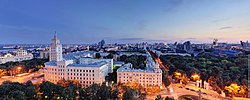Voronezh
| Voronezh (English) Воронеж (Russian) |
|
|---|---|
| - City - | |
 View of Voronezh |
|
|
|
|
|
|
|
|
|
|
| City Day | Third Saturday of September |
| Administrative status (as of December 2011) | |
| Country | Russia |
| Federal subject | Voronezh Oblast |
| Administratively subordinated to | Voronezh Urban Okrug |
| Administrative center of | Voronezh Oblast, Voronezh Urban Okrug |
| Municipal status (as of October 2005) | |
| Urban okrug | Voronezh Urban Okrug |
| Administrative center of | Voronezh Urban Okrug |
| Mayor | Gusev Alexander (acting) |
| Representative body | City Duma |
| Statistics | |
| Area | 601 km2 (232 sq mi) |
| Population (2010 Census) | 889,680 inhabitants |
| - Rank in 2010 | 15th |
| Population (January 1, 2016 est.) | 1,032,895 inhabitants |
| Density | 1,480/km2 (3,800/sq mi) |
| Time zone | MSK (UTC+03:00) |
| Founded | 1585 or much earlier |
| City status since | 1585 |
| Postal code(s) | 394000–394095 |
| Dialing code(s) | +7 473 |
|
|
|
| on | |
Voronezh (Russian: Воро́неж; IPA: [vɐˈronʲɪʂ]) is a city and the administrative center of Voronezh Oblast, Russia, straddling the Voronezh River and located 12 kilometers (7.5 mi) from where it flows into the Don. The city sits on the Southeastern Railway, which connects European Russia with the Urals and Siberia, the Caucasus and Ukraine, and the M4 highway (Moscow–Voronezh–Rostov-on-Don-Novorossiysk). Its population in 2016 was estimated to be 1,032,895; up from 889,680 recorded in the 2010 Census.
Voronezh originates as a settlement of the Kievan Rus in about the 12th century, first mentioned in the Hypatian Codex (dated 1177). The Voronezh River is likely named for the settlement, then in the Principality of Chernigov. The toponym is usually derived from a Slavic personal name Voroneg, apparently a derivation from "raven", The comparative analysis of the name "Voronezh" was carried out by the Khovansky Foundation in 2009.
...
Wikipedia



